| Part of a series on |
| Wildlife of Sri Lanka |
|---|
 |
Sri Lanka is a tropical island situated close to the southern tip of India. It is situated in the middle of the Indian Ocean. This is a partial list of fish species introduced to Sri Lanka.
| Part of a series on |
| Wildlife of Sri Lanka |
|---|
 |
Sri Lanka is a tropical island situated close to the southern tip of India. It is situated in the middle of the Indian Ocean. This is a partial list of fish species introduced to Sri Lanka.
Since Sri Lanka was ruled by the Portuguese, Dutch, and British. At various junctures, these nations introduced a number of exotic species, which included mammals, plants, birds, and fish. After Sri Lanka secured its independence, the introductions continued unabated, and the breeding of exotic aquarium fish for export became popular.
The deliberate and accidental introduction of exotic fish into Sri Lanka has led to serious ecological damage, as many of these species disrupt ecosystems, reducing the diversity of endemic fish to a degree that causes extinction. Invasive introduced exotic fish, such as the Sail-fin pleco, also cause economic damage by reducing the amount of local fish caught by fishermen while being of no or little economical value themselves. Most of the invasive exotic fish were originally brought for commercial purposes, mainly as aquarium fish and for food.
An introduced, alien, exotic, non-indigenous, or non-nativespecies, or simply an introduction, is a species living outside its native distributional range, which has arrived there by human activity, either deliberate or accidental. Non-native species can have various effects on the local ecosystem. Introduced species that become established and spread beyond the place of introduction are called invasive species. Some have a negative effect on a local ecosystem. Some introduced species may have no negative effect or only minor impact. Some species have been introduced intentionally to combat pests.
There are 24 introduced fish species which inhabit all freshwater, brackish water and marine waters.
Cyprinids are stomachless fish with toothless jaws. Even so, food can be effectively chewed by the gill rakers of the specialized last gill bow.
| Name | Binomial | Status | Image |
|---|---|---|---|
| Bighead carp | Hypophthalmichthys nobilis |  | |
| Goldfish | Carassius auratus | 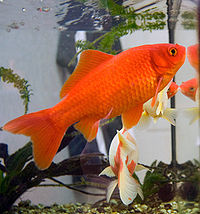 | |
| Indian carp | Catla catla | 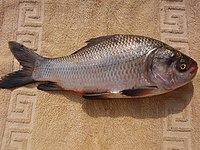 | |
| Grass carp | Ctenopharyngodon idella | 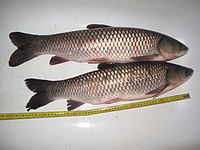 | |
| Common carp | Cyprinus carpio | 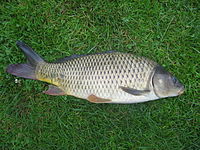 | |
| Silver carp | Hypophthalmichthys molitrix |  | |
| Mrigal carp | Cirrhinus mrigala | ||
| Rohu | Labeo rohita | 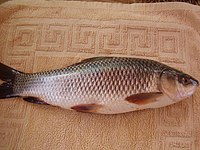 |
All salmonids spawn in fresh water, but in many cases, the fish spend most of their lives at sea, returning to the rivers only to reproduce. This lifecycle is described as anadromous. They are slender fish, with rounded scales and forked tails.
| Name | Binomial | Status | Image |
|---|---|---|---|
| Rainbow trout | Oncorhynchus mykiss | invasive |  |
They are extensively used for mosquito control, poeciliids can today be found in all tropical and subtropical areas of the world.
| Name | Binomial | Status | Image |
|---|---|---|---|
| Mosquitofish | Gambusia affinis |  | |
| Guppy | Poecilia reticulata |  | |
| Green swordtail | Xiphophorus hellerii | 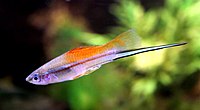 | |
| Common platy | Xiphophorus maculatus | 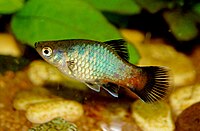 |
Cichlids are popular freshwater fish kept in the home aquarium. Cichlids tend to be of medium size, ovate in shape, and slightly laterally compressed, and generally similar to the North American sunfishes in morphology, behavior, and ecology.
| Name | Binomial | Status | Image |
|---|---|---|---|
| Redbreast tilapia | Coptodon rendalli | 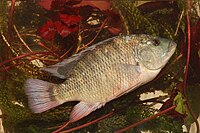 | |
| African jewelfish | Hemichromis bimaculatus |  | |
| Nile tilapia | Oreochromis niloticus |  | |
| Mossambique tilapia | Oreochromis mossambicus | 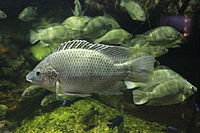 | |
| Wami tilapia | Oreochromis urolepis | ||
| Redbelly tilapia | Tilapia zillii |
Many gouramis have an elongated, feeler-like ray at the front of each of their pelvic fins. Many species show parental care: some are mouthbrooders.
| Name | Binomial | Status | Image |
|---|---|---|---|
| Snakeskin gourami | Trichopodus pectoralis |  | |
| Three spot gourami | Trichopodus trichopterus | 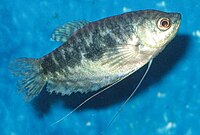 | |
| Giant gourami | Osphronemus goramy |  |
Single species is known. The kissing gourami is a popular aquarium fish.
| Name | Binomial | Status | Image |
|---|---|---|---|
| Kissing gourami | Helostoma temminckii |  |
These fish are noted for the bony plates covering their bodies and their suckermouths. They are popular as aquarium fish.
| Name | Binomial | Status | Image |
|---|---|---|---|
| Sail-fin pleco | Pterygoplichthys multiradiatus |  |
Known as knifefish or featherbacks, have slender, elongated, bodies, giving them a knife-like appearance. The caudal fin is small and fused with the anal fin, which runs most of the length of the body. Where present, the dorsal fin is small and narrow, giving rise to the common name of "featherback".
| Name | Binomial | Status | Image |
|---|---|---|---|
| Clown knifefish | Chitala ornata | invasive | 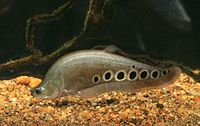 |

Gouramis, or gouramies, are a group of freshwater anabantiform fish that comprise the family Osphronemidae. The fish are native to Asia—from the Indian Subcontinent to Southeast Asia and northeasterly towards Korea. The name "gourami", of Indonesian origin, is also used for fish of the families Helostomatidae and Anabantidae.
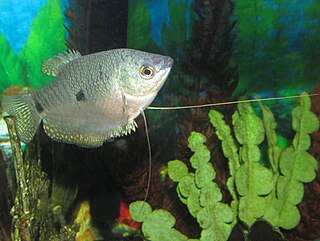
The three spot gourami, also known as the opaline gourami, blue gourami, and gold gourami, is a species of fish native to southeastern Asia, but also introduced elsewhere. This gourami gets its name from the two spots along each side of its body in line with the eye, considered the third spot. This species is of minor commercial importance as a food fish in its native range and is also farmed. It is also popular in the aquarium trade. The species reaches 15 cm in standard length.
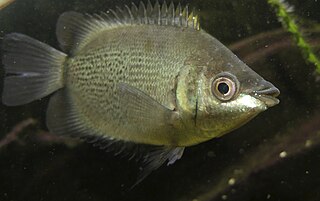
Kissing gouramis, also known as kissing fish or kissers, are medium-sized tropical freshwater fish comprising the monotypic labyrinth fish family Helostomatidae. These fish originate from Mainland Southeast Asia, the Greater Sundas and nearby smaller islands, but have also been introduced outside their native range. They are regarded as a food fish and they are sometimes farmed. They are used fresh for steaming, baking, broiling, and pan frying. The kissing gourami is a popular aquarium fish.
Community aquaria are tanks that are designed to contain more than one species of fish. Most commonly they include a variety of species that do not normally occur together in nature, for example angelfish from Brazil, swordtails from Mexico, and gouramis from South East Asia. The aim of such communities is to bring together fish that are compatible in temperament and water requirements, while using their different colours and behaviors to add interest and entertainment value.

Fishkeeping is a popular hobby, practiced by aquarists, concerned with keeping fish in a home aquarium or garden pond. There is also a piscicultural fishkeeping industry, serving as a branch of agriculture.
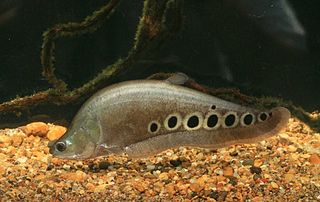
The family Notopteridae contains 10 species of osteoglossiform (bony-tongued) fishes, commonly known as featherbacks and knifefishes. These fishes live in freshwater or brackish environments in Africa and South and Southeast Asia.
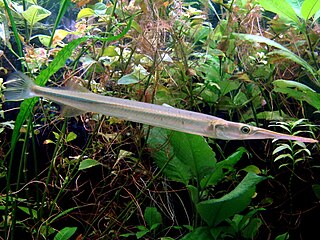
Xenentodon cancila, the freshwater garfish, is a species of needlefish found in freshwater and brackish habitats in South and Southeast Asia.

Pethia stoliczkana is a fresh water tropical cyprinid fish native to the upper Mekong, Salwen, Irrawaddy, Meklong and upper Charo Phraya basins in the countries of Nepal, India, Pakistan, Myanmar, Bangladesh, Laos, Thailand, China and Sri Lanka.

The thick-lipped gourami is a species of gourami native to Southeast Asia, and is a popular aquarium fish.

Taraporewala Aquarium or Taraporevala Aquarium is India's oldest aquarium and one of Mumbai's main attractions. It hosts marine and freshwater fish. The aquarium is located on Marine Drive.

The Shanghai Ocean Aquarium is a public aquarium located in Shanghai, China.

The snakeskin gourami is a species of gourami native to Southeast Asia. Prior to the merging of Belontidae to the family Osphronemidae, the snakeskin gourami was regarded as the largest member of its family. It is still the largest species in its genus and subfamily.

A freshwater aquarium is a receptacle that holds one or more freshwater aquatic organisms for decorative, pet-keeping, or research purposes. Modern aquariums are most often made from transparent glass or acrylic glass. Typical inhabitants include fish, plants, amphibians, and invertebrates, such as snails and crustaceans.
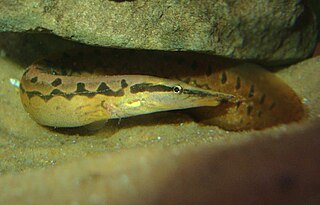
The zig-zag eel, also known as the tire-track eel, tire-track spiny eel or marbled spiny eel, is a species of ray-finned, spiny eels belonging to the genus Mastacembelus of the family Mastacembelidae, and is native to the riverine fauna of India, Bangladesh, Pakistan, Sri Lanka, Thailand, Vietnam, Indonesia and other parts of Southeast Asia. The species was described as Macrognathus armatus by Lacepède in 1800. Other common names for this popular aquarium species are leopard spiny eel and white-spotted spiny eel. This species is not only a popular aquarium fish but also as a food fish in its country of origin.

The clown featherback, also known as the clown knifefish and spotted knifefish, is a nocturnal species of tropical fish with a long, knife-like body. This knifefish is native to freshwater habitats in Cambodia, China, Hong Kong, Laos, Macau, Taiwan, Thailand, and Vietnam, but it has also been introduced to regions outside its native range. It is one of the world's most invasive species.

The green chromide is a species of cichlid fish that is native to fresh and brackish water habitats in some parts in India such as Kerala, Goa, Chilika Lake in Odisha and Sri Lanka. The species was first described by Marcus Elieser Bloch in 1790. This species and other members of the genus Etroplus are relatively closely related to the Paretroplus cichlids from Madagascar.

Southwestern Sri Lanka rivers and streams is a freshwater ecoregion in Sri Lanka. The ecoregion is listed in Global 200, a list of ecoregions compiled by the World Wide Fund for Nature for conservation priorities. The extensive network of rivers and streams of Sri Lanka drains a total of 103 distinct natural river basins. Several waterfall habitats have been formed as a result of rivers and streams flowing through high and mid elevation areas. The ecoregion spreads over 15,500 km2 in the wet zone of the southwestern part of Sri Lanka. More than a quarter of the freshwater fishes that have been discovered in Southwestern Sri Lanka rivers and streams are endemic. Nine endemic genera of freshwater fishes of Western Ghats and Sri Lanka hotspot Malpulutta are found only in Sri Lanka. Studies suggest that the number of species still to be discovered is quite high. Until recently wetlands in Sri Lanka were used for drainage, construction sites and land fills.
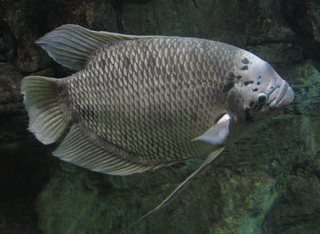
The giant gourami is a species of large gourami native to freshwater habitats in Southeast Asia. It has also been introduced elsewhere. The species is commercially important as a food fish and is also farmed. It can be found in the aquarium trade, as well. The species has been used for weed control on highly invasive aquatic plants like Salvinia molesta, as the giant gourami can be a voracious herbivore.